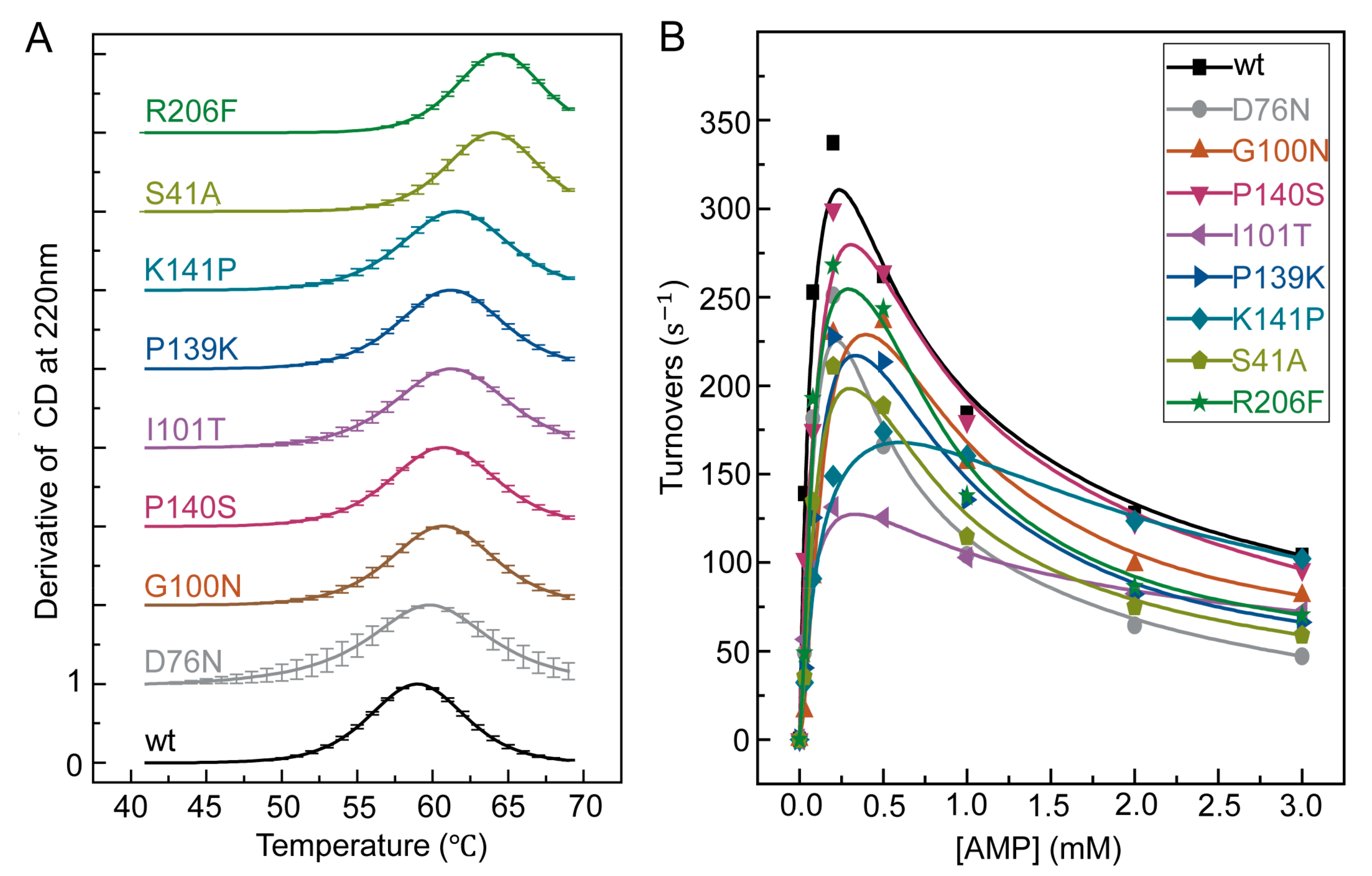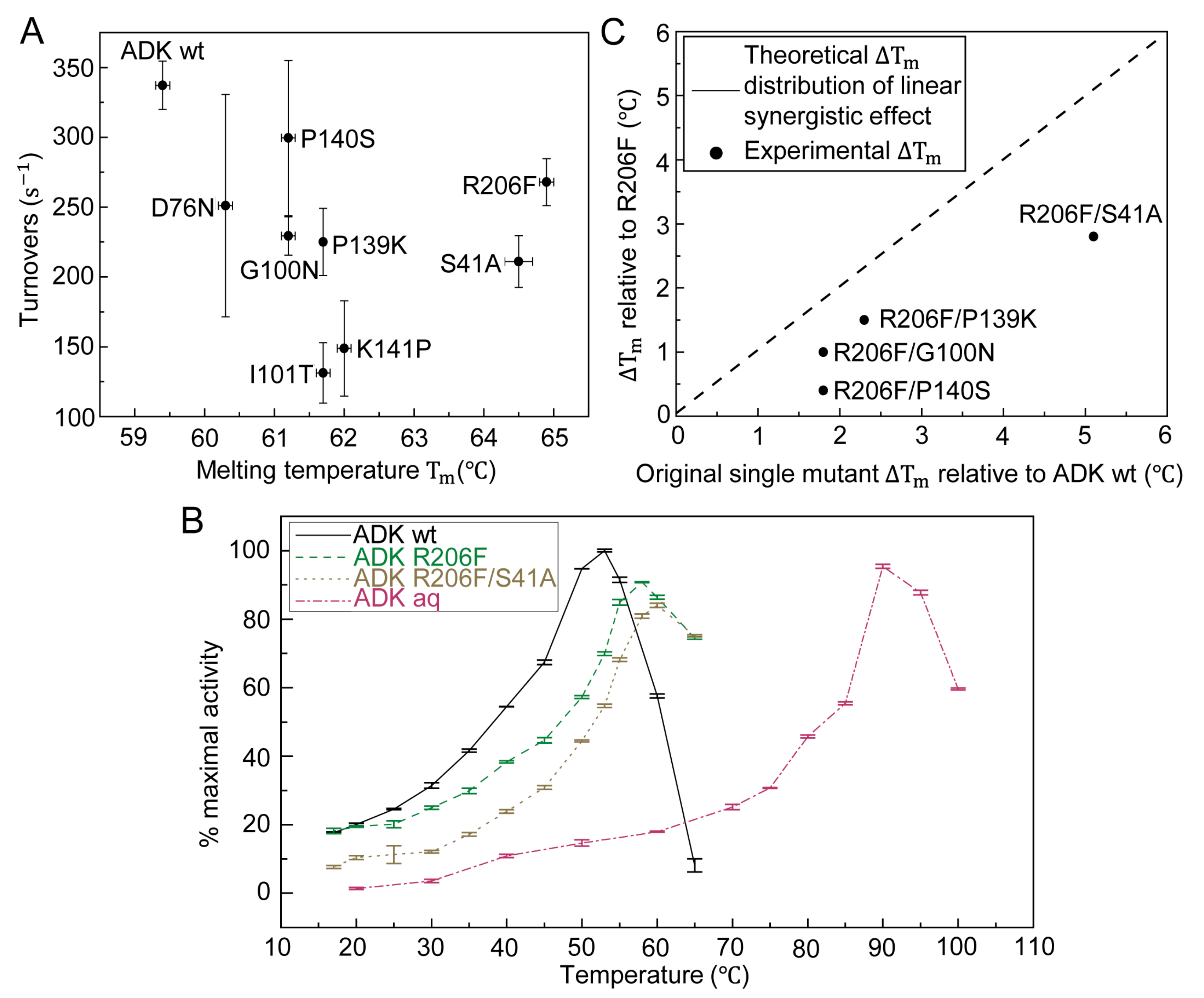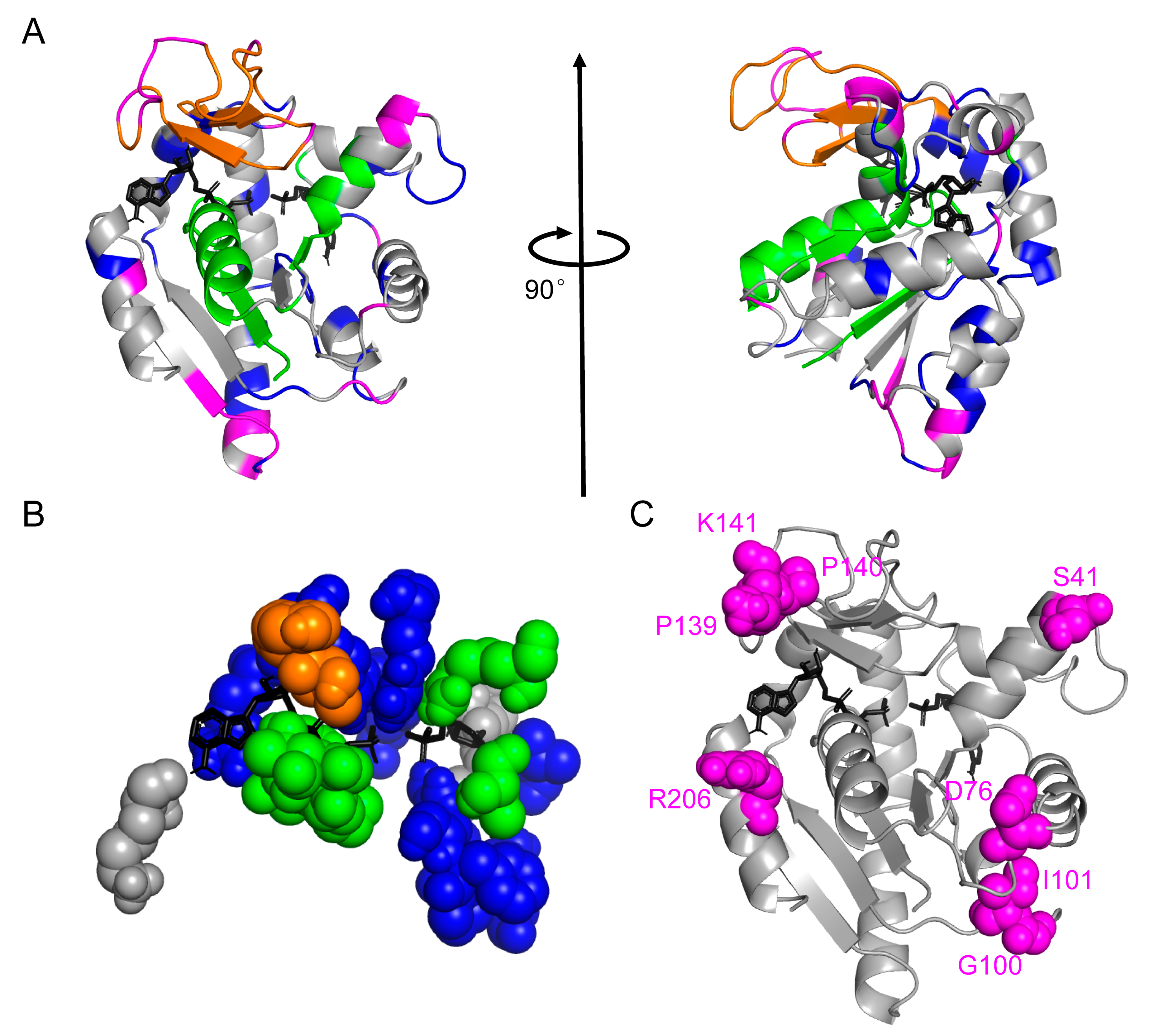Rational Design of Adenylate Kinase Thermostability through Coevolution and Sequence Divergence Analysis
Abstract
1. Introduction
2. Results
2.1. Protein Sectors Derived from Amino Acid Sequences
2.2. Thermostability-Related Sector Identification and Mutant Design
2.3. Thermostability Characterization of Mutants
3. Discussion
4. Materials and Methods
4.1. Primary-Sequence-Based Thermostability Design
- Construct a multiple sequence alignment for the target protein family.
- Apply RCA to the MSA to obtain a correlation matrix.
- Identify protein sectors through the eigen-decomposition of the correlated matrix.
- Calculate the relative entropy angle θ from the difference between mesophiles and thermophiles. The protein sector with the largest average θ should be picked out for further selection of mutation sites.
- Replace residues whose θ exceed a certain threshold with the corresponding amino acids which were the most common among thermophiles or whose side chains had distinct properties.
- Characterize the mutants by circular dichroism measurement and enzymatic activity assay.
- Consider constructing double-point mutations consisting of above characterized single-point mutation sites.
4.2. Sequence Alignment and Curation
4.3. Coevolution Analysis
4.4. Sequence Entropy Analysis
4.5. Materials
4.6. ADK Purification
4.7. Room Temperature Forward Activity Assay of ADK
4.8. CD Temperature Melt Measurement
4.9. Temperature-Dependent Enzymatic Activity Assay
5. Conclusions
Supplementary Materials
Author Contributions
Funding
Institutional Review Board Statement
Informed Consent Statement
Data Availability Statement
Acknowledgments
Conflicts of Interest
Abbreviations
| ADK | adenylate kinase |
| ADK aq | Aquifex aeolicus ADK |
| ADK wt | E. coli ADK |
| ADP | adenosine diphosphate |
| AMP | adenosine monophosphate |
| Ap5A | P1,P5-Di(adenosine-5′) pentaphosphate pentasodium salt |
| ATP | adenosine triphosphate |
| BSA | bovine serum albumen |
| CD | circular dichroism |
| E. coli | Escherichia coli |
| HMM | hidden Markov model |
| ICE | improved configurational entropy |
| MgOAc2 | magnesium acetate |
| MSA | multiple sequence alignment |
| NADH | nicotinamide adenine dinucleotide disodium salt |
| PEP | phosphoenolpyruvate |
| PK/LDH | pyruvate kinase/lactic dehydrogenase |
| RCA | residue correlation analysis |
| TCEP | Tris(2-carboxyethyl)phosphine hydrochloride |
| Tm | melting temperature |
References
- Magliery, T.J. Protein Stability: Computation, Sequence Statistics, and New Experimental Methods. Curr. Opin. Struct. Biol. 2015, 33, 161–168. [Google Scholar] [CrossRef]
- As, B.; Jk, B.; Mj, A. Status of Protein Engineering for Biocatalysts: How to Design an Industrially Useful Biocatalyst. Available online: https://pubmed.ncbi.nlm.nih.gov/21115265/ (accessed on 14 July 2020).
- Wang, G.; Cao, R.-Y.; Chen, R.; Mo, L.; Han, J.-F.; Wang, X.; Xu, X.; Jiang, T.; Deng, Y.-Q.; Lyu, K.; et al. Rational Design of Thermostable Vaccines by Engineered Peptide-Induced Virus Self-Biomineralization under Physiological Conditions. Proc. Natl. Acad. Sci. USA 2013, 110, 7619–7624. [Google Scholar] [CrossRef]
- Deller, M.C.; Kong, L.; Rupp, B. Protein Stability: A Crystallographer’s Perspective. Acta Cryst. F Struct. Biol. Commun. 2016, 72, 72–95. [Google Scholar] [CrossRef] [PubMed]
- Cobb, R.E.; Sun, N.; Zhao, H. Directed Evolution as a Powerful Synthetic Biology Tool. Methods 2013, 60, 81–90. [Google Scholar] [CrossRef] [PubMed]
- Schweiker, K.L.; Zarrine-Afsar, A.; Davidson, A.R.; Makhatadze, G.I. Computational Design of the Fyn SH3 Domain with Increased Stability through Optimization of Surface Charge–Charge Interactions. Protein Sci. 2007, 16, 2694–2702. [Google Scholar] [CrossRef] [PubMed]
- Dehouck, Y.; Grosfils, A.; Folch, B.; Gilis, D.; Bogaerts, P.; Rooman, M. Fast and Accurate Predictions of Protein Stability Changes upon Mutations Using Statistical Potentials and Neural Networks: PoPMuSiC-2.0. Bioinformatics 2009, 25, 2537–2543. [Google Scholar] [CrossRef] [PubMed]
- Alford, R.F.; Leaver-Fay, A.; Jeliazkov, J.R.; O’Meara, M.J.; DiMaio, F.P.; Park, H.; Shapovalov, M.V.; Renfrew, P.D.; Mulligan, V.K.; Kappel, K.; et al. The Rosetta All-Atom Energy Function for Macromolecular Modeling and Design. J. Chem. Theory Comput. 2017, 13, 3031–3048. [Google Scholar] [CrossRef]
- Bae, E.; Bannen, R.M.; Phillips, G.N. Bioinformatic Method for Protein Thermal Stabilization by Structural Entropy Optimization. Proc. Natl. Acad. Sci. USA 2008, 105, 9594–9597. [Google Scholar] [CrossRef]
- Chan, C.-H.; Liang, H.-K.; Hsiao, N.-W.; Ko, M.-T.; Lyu, P.-C.; Hwang, J.-K. Relationship between Local Structural Entropy and Protein Thermostabilty. Proteins Struct. Funct. Bioinform. 2004, 57, 684–691. [Google Scholar] [CrossRef]
- Moon, S.; Bannen, R.M.; Rutkoski, T.J.; Phillips Jr., G.N.; Bae, E. Effectiveness and Limitations of Local Structural Entropy Optimization in the Thermal Stabilization of Mesophilic and Thermophilic Adenylate Kinases. Proteins Struct. Funct. Bioinform. 2014, 82, 2631–2642. [Google Scholar] [CrossRef]
- Sternke, M.; Tripp, K.W.; Barrick, D. Consensus Sequence Design as a General Strategy to Create Hyperstable, Biologically Active Proteins. Proc. Natl. Acad. Sci. USA 2019, 116, 11275–11284. [Google Scholar] [CrossRef]
- Wolf-Watz, M.; Thai, V.; Henzler-Wildman, K.; Hadjipavlou, G.; Eisenmesser, E.Z.; Kern, D. Linkage between Dynamics and Catalysis in a Thermophilic-Mesophilic Enzyme Pair. Nat. Struct. Mol. Biol. 2004, 11, 945–949. [Google Scholar] [CrossRef]
- Huang, X.; Zheng, W.; Pearce, R.; Zhang, Y. SSIPe: Accurately Estimating Protein–Protein Binding Affinity Change upon Mutations Using Evolutionary Profiles in Combination with an Optimized Physical Energy Function. Bioinformatics 2020, 36, 2429–2437. [Google Scholar] [CrossRef]
- Burlacu-Miron, S.; Perrier, V.; Gilles, A.-M.; Pistotnik, E.; Craescu, C.T. Structural and Energetic Factors of the Increased Thermal Stability in a Genetically Engineered Escherichia Coli Adenylate Kinase. J. Biol. Chem. 1998, 273, 19102–19107. [Google Scholar] [CrossRef] [PubMed]
- Göbel, U.; Sander, C.; Schneider, R.; Valencia, A. Correlated Mutations and Residue Contacts in Proteins. Proteins Struct. Funct. Bioinform. 1994, 18, 309–317. [Google Scholar] [CrossRef] [PubMed]
- Halabi, N.; Rivoire, O.; Leibler, S.; Ranganathan, R. Protein Sectors: Evolutionary Units of Three-Dimensional Structure. Cell 2009, 138, 774–786. [Google Scholar] [CrossRef] [PubMed]
- Ainsworth, S.; Macfarlane, N. A Kinetic Study of Rabbit Muscle Pyruvate Kinase. Biochem. J. 1973, 131, 223–236. [Google Scholar] [CrossRef]
- Tan, Y.-W.; Hanson, J.A.; Yang, H. Direct Mg2+ Binding Activates Adenylate Kinase from Escherichia Coli. J. Biol. Chem. 2009, 284, 3306–3313. [Google Scholar] [CrossRef]
- Rigoldi, F.; Donini, S.; Redaelli, A.; Parisini, E.; Gautieri, A. Review: Engineering of Thermostable Enzymes for Industrial Applications. APL Bioeng. 2018, 2, 011501. [Google Scholar] [CrossRef] [PubMed]
- Moon, S.; Jung, D.; Phillips Jr., G.N.; Bae, E. An Integrated Approach for Thermal Stabilization of a Mesophilic Adenylate Kinase. Proteins Struct. Funct. Bioinform. 2014, 82, 1947–1959. [Google Scholar] [CrossRef]
- Perrier, V.; Burlacu-Miron, S.; Bourgeois, S.; Surewicz, W.K.; Gilles, A.-M. Genetically Engineered Zinc-Chelating Adenylate Kinase From Escherichia Coli with Enhanced Thermal Stability. J. Biol. Chem. 1998, 273, 19097–19101. [Google Scholar] [CrossRef] [PubMed]
- Hanson, J.A.; Duderstadt, K.; Watkins, L.P.; Bhattacharyya, S.; Brokaw, J.; Chu, J.-W.; Yang, H. Illuminating the Mechanistic Roles of Enzyme Conformational Dynamics. Proc. Natl. Acad. Sci. USA 2007, 104, 18055–18060. [Google Scholar] [CrossRef]
- Tamaki, F.K.; Textor, L.C.; Polikarpov, I.; Marana, S.R. Sets of Covariant Residues Modulate the Activity and Thermal Stability of GH1 β-Glucosidases. PLoS ONE 2014, 9, e96627. [Google Scholar] [CrossRef] [PubMed]
- Pucci, F.; Bernaerts, K.V.; Kwasigroch, J.M.; Rooman, M. Quantification of Biases in Predictions of Protein Stability Changes upon Mutations. Bioinformatics 2018, 34, 3659–3665. [Google Scholar] [CrossRef] [PubMed]
- Guerois, R.; Nielsen, J.E.; Serrano, L. Predicting Changes in the Stability of Proteins and Protein Complexes: A Study of More than 1000 Mutations. Available online: https://pubmed.ncbi.nlm.nih.gov/12079393/ (accessed on 14 July 2020).
- Xiong, P.; Wang, M.; Zhou, X.; Zhang, T.; Zhang, J.; Chen, Q.; Liu, H. Protein Design with a Comprehensive Statistical Energy Function and Boosted by Experimental Selection for Foldability. Nat. Commun. 2014, 5, 1–9. [Google Scholar] [CrossRef]
- The UniProt Consortium. UniProt: A Worldwide Hub of Protein Knowledge. Nucleic Acids Res. 2019, 47, D506–D515. [Google Scholar] [CrossRef]
- Pearce, R.; Huang, X.; Setiawan, D.; Zhang, Y. EvoDesign: Designing Protein-Protein Binding Interactions Using Evolutionary Interface Profiles in Conjunction with an Optimized Physical Energy Function. Available online: https://pubmed.ncbi.nlm.nih.gov/30851277/ (accessed on 14 July 2020).
- Structure-Based Mutant Stability Predictions on Proteins of Unknown Structure. J. Biotechnol. 2012, 161, 287–293. [CrossRef] [PubMed]
- Capriotti, E.; Fariselli, P.; Casadio, R. I-Mutant2.0: Predicting Stability Changes upon Mutation from the Protein Sequence or Structure. Nucleic Acids Res. 2005, 33, W306–W310. [Google Scholar] [CrossRef]
- Huang, L.-T.; Gromiha, M.M.; Ho, S.-Y. IPTREE-STAB: Interpretable Decision Tree Based Method for Predicting Protein Stability Changes upon Mutations. Bioinformatics 2007, 23, 1292–1293. [Google Scholar] [CrossRef]
- Cheng, J.; Randall, A.; Baldi, P. Prediction of Protein Stability Changes for Single-Site Mutations Using Support Vector Machines. Proteins Struct. Funct. Bioinform. 2006, 62, 1125–1132. [Google Scholar] [CrossRef]
- Folkman, L.; Stantic, B.; Sattar, A.; Zhou, Y. EASE-MM: Sequence-Based Prediction of Mutation-Induced Stability Changes with Feature-Based Multiple Models. Available online: https://pubmed.ncbi.nlm.nih.gov/26804571/ (accessed on 20 October 2020).
- Punta, M.; Coggill, P.C.; Eberhardt, R.Y.; Mistry, J.; Tate, J.; Boursnell, C.; Pang, N.; Forslund, K.; Ceric, G.; Clements, J.; et al. The Pfam Protein Families Database. Nucleic Acids Res. 2012, 40, D290–D301. [Google Scholar] [CrossRef] [PubMed]
- Sievers, F.; Wilm, A.; Dineen, D.; Gibson, T.J.; Karplus, K.; Li, W.; Lopez, R.; McWilliam, H.; Remmert, M.; Söding, J.; et al. Fast, Scalable Generation of High-Quality Protein Multiple Sequence Alignments Using Clustal Omega. Mol. Syst. Biol. 2011, 7, 539. [Google Scholar] [CrossRef] [PubMed]
- Tatusova, T.; Ciufo, S.; Fedorov, B.; O’Neill, K.; Tolstoy, I. RefSeq Microbial Genomes Database: New Representation and Annotation Strategy. Nucleic Acids Res. 2014, 42, D553–D559. [Google Scholar] [CrossRef] [PubMed]
- Bae, E.; Phillips, G.N. Structures and Analysis of Highly Homologous Psychrophilic, Mesophilic, and Thermophilic Adenylate Kinases. J. Biol. Chem. 2004, 279, 28202–28208. [Google Scholar] [CrossRef] [PubMed]




| Protein | Melting Temperature (°C) |
|---|---|
| ADK wt | 59.40.1 |
| D76N | 60.3 |
| G100N | 61.20.1 |
| P140S | 61.20.1 |
| I101T | 61.70.1 |
| P139K | 61.70.0 |
| K141P | 62.00.1 |
| S41A | 64.50.2 |
| R206F | 64.90.1 |
| R206F/P140S | 65.30.2 |
| R206F/G100N | 65.90.2 |
| R206F/P139K | 66.40.1 |
| R206F/S41A | 67.70.3 |
Publisher’s Note: MDPI stays neutral with regard to jurisdictional claims in published maps and institutional affiliations. |
© 2021 by the authors. Licensee MDPI, Basel, Switzerland. This article is an open access article distributed under the terms and conditions of the Creative Commons Attribution (CC BY) license (http://creativecommons.org/licenses/by/4.0/).
Share and Cite
Chang, J.; Zhang, C.; Cheng, H.; Tan, Y.-W. Rational Design of Adenylate Kinase Thermostability through Coevolution and Sequence Divergence Analysis. Int. J. Mol. Sci. 2021, 22, 2768. https://doi.org/10.3390/ijms22052768
Chang J, Zhang C, Cheng H, Tan Y-W. Rational Design of Adenylate Kinase Thermostability through Coevolution and Sequence Divergence Analysis. International Journal of Molecular Sciences. 2021; 22(5):2768. https://doi.org/10.3390/ijms22052768
Chicago/Turabian StyleChang, Jian, Chengxin Zhang, Huaqiang Cheng, and Yan-Wen Tan. 2021. "Rational Design of Adenylate Kinase Thermostability through Coevolution and Sequence Divergence Analysis" International Journal of Molecular Sciences 22, no. 5: 2768. https://doi.org/10.3390/ijms22052768
APA StyleChang, J., Zhang, C., Cheng, H., & Tan, Y.-W. (2021). Rational Design of Adenylate Kinase Thermostability through Coevolution and Sequence Divergence Analysis. International Journal of Molecular Sciences, 22(5), 2768. https://doi.org/10.3390/ijms22052768








